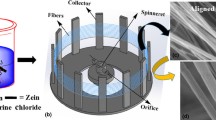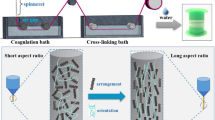Abstract
The development of functionalized braided wires coated with chitosan that can be used for tissue suturing and tissue regeneration is the subject of this work. Poly(l-lactic acid) (PLLA) braided wires were successfully fabricated by combining an electrospinning technique and alignment collection with a mini-type braiding method. The resulting PLLA wires with and without chitosan coating were characterized through a variety of methods including scanning electron microscopy (SEM), X-ray photoelectronic spectra (XPS) and tensile mechanical testing. Hemolytic property, kinetic hemostasis behavior, platelet adhesion, erythrocyte adhesion, and water uptake ability of the wires were explored. The results showed that a nearly comparable mechanical behavior of the braided wires with some commercial suture could be obtained with well-aligned fibers, and no significant difference in tensile performances were recognized with and without the introduction of chitosan. The PLLA wires coated with chitosan were found to have better prohemostatic activity than those without a chitosan coating.














Similar content being viewed by others
References
Chu CC. Textile-based biomaterials for surgical applications. In: Dumitriu S, editor. Polymeric iomaterials. 2nd ed. New York: Marcel Dekker; 2002. p. 167–86.
Lee K-H, Chu CC. The role of superoxide ions in the degradation of synthetic absorbable sutures. J Biomed Mater Res. 2000;49:25–35.
Ooi CP, Cameron RE. The hydrolytic degradation of polydioxanone (PDSII) sutures. Part I: morphological aspects. J Biomed Mater Res (Appl Biomater). 2002;63:280–90.
Makela P, Pohjonen T, Tormala P, Waris T, Ashammakhi N. Strength retention properties of self-reinforced poly l-lactide (SRPLLA) sutures compared with polyglyconate (Maxons) and polydioxanone (PDS) sutures. An in vitro study. Biomaterials. 2002;23:2587–92.
Wissing J, Van Vroonhoven TJMV, Schattenkerk ME, et al. Fascia closure after midline laparotomy: results of a randomized trial. Br J Surg. 1987;74:738.
Lewis RT, Wiegand FM. Nature history of vertical abdominal parietal closure: prolene versus dexon. Can J Surg. 1989;32:196.
Adekogbe I, Ghanem A. Fabrication and characterization of DTBP-crosslinked chitosan scaffolds for skin tissue engineering. Biomaterials. 2005;26:7241–50.
Huang ZM, Zhang YZ, Kotaki M, Ramakrishna S. A review on polymer nanofibers by electrospinning and their applications in nanocomposites. Compos Sci Technol. 2003;63:2223–53.
Ramakrishna S, Fujihara K, Teo W-E, et al. Electrospun nanofibers: solving global issues. Mater Today. 2006;9(3):40–50.
Khil M-S, Cha D-I, Kim H-Y, et al. Electrospun nanofibrous polyurethane membrane as wound dressing. Mater Res B: Appl Biomater. 2003;67(2):675–9.
Katti DS, Robinson KW, Ko FK, et al. Bioresorbable nanofiber-based systems for wound healing and drug delivery: optimization of fabrication parameters. Mater Res B: Appl Biomater. 2004;70(2):286–96.
Huang ZM, He CL, Yang AZ, Zhang YZ, Han XJ, Yin JL, et al. Encapsulating drugs in biodegradable ultrafine fibers through co-axial electrospinning. J Biomed Mater Res. 2006;77A(1):169–79.
Barie PS. Surgical site infections: epidemiology and prevention. Surg Infect. 2002;3(S1):9–21.
He CL, Huang ZM, Han XJ. Fabrication of drug loaded electrospun aligned fibrous threads for suture applications. J Biomed Mater Res A. 2009;89A(1):80–95.
Haas DW, Kaiser AB. Antimicrobial prophylaxis of infections associated with foreign bodies. In: Waldvogel FA, Bisno AL, editors. Infections associated with indwelling medical devices. 3rd ed. Washington, DC: ASM Press; 2000.
Malette WG, William G, Quigley HJ, et al. Method of achieving hemostasis. US Patent 4394373. 6 July 1983.
Klokkevold PR, Lew DS, Ellis DG, Bertolami CN. Effect of chitosan on lingual hemostasis in rabbits. J Oral Maxillofac Surg. 1991;49:858–63.
Klokkevold PR, Subar P, Fukayama H, Bertolami CN. Effect of chitosan on lingual hemostasis in rabbits with platelet dysfunction induced by epoprostenol. J Oral Maxillofac Surg. 1992;50:41–5.
ASTM D 2256-02: Standard test methods for testing properties of yarns by the single-strand method, ASTM International. ASTM: West Conshohocken, PA; 2000.
Lawrie G, Keen I, Drew B, et al. Interactions between alginate and chitosan biopolymers characterized using FTIR and XPS. Biomacromolecules. 2007;8:2533–41.
USP 30-NF 25, Absorbable surgical suture.
Zobel HP, Stieneker F, Atmaca-Abdel Aziz S. Evaluation of aminoalkylmethacrylate nanoparticles as colloidal drug carrier systems. Part 2. characterization of antisense oligonucleotides loaded copolymer nanoparticles. J Pharm Biopharm. 1999;48:1.
Hou C, Yuan Q, Huo D, Zheng S, Zhan D. Investigation on clotting and hemolysis characteristics of heparin-immobilized polyether sulfones biomembrane. J Biomed Mater Res. 2008;85A:847–52.
Yang YD, Yu JG, Zhou YG, et al. Preparation and blood compatibility of oxidized-chitosan films. Chin Chem Lett. 2005;16(7):991–4.
Bick RL. Clinical evaluation of the patient with hemorrhage. In: Bick RL, Bennett J, Brynes R, et al., editors. Hematology: clinical and laboratory practice; vol 2. Mosby: St. Louis, MO; 1993. p. 1285.
Bithell, TC. The physiology of primary hemostasis. In: Lee GR, et al., editors. Wintrobe's Clinical Hematology. vol 1. Lea & Febiger: Philadelphia; 1993. p. 540.
Janvikul W, Uppanan P, Thavornyutikarn B, Krewraing J, Prateepasen R. In vitro comparative hemostatic studies of chitin, chitosan, and their derivatives. J Appl Polym Sci. 2006;102:445–51.
Okamoto Y, Yano R, Miyatake K, et al. Efects of chitin and chitosan on blood coagulation. Carbohydr Polym. 2003;53(3):337–42.
Hou CL, Gu QS. Chitin and medicine. Shanghai: The Shanghai Science and Technology Press; 2001. p. 58–61.
Lee KY, Ha WS, Park WH. Blood compatibility and biodegradability of partially N-acylated chitosan derivatives. Biomaterials. 1995;16:1211–6.
Acknowledgment
This research is partially financially supported by the National Natural Science Foundations of China with a grant number of 50773054.
Author information
Authors and Affiliations
Corresponding author
Rights and permissions
About this article
Cite this article
Hu, W., Huang, ZM., Meng, SY. et al. Fabrication and characterization of chitosan coated braided PLLA wire using aligned electrospun fibers. J Mater Sci: Mater Med 20, 2275–2284 (2009). https://doi.org/10.1007/s10856-009-3797-y
Received:
Accepted:
Published:
Issue Date:
DOI: https://doi.org/10.1007/s10856-009-3797-y




